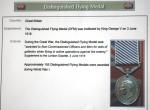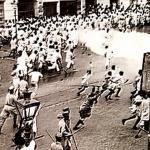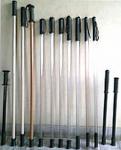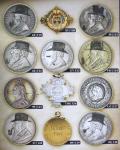-
Posts
13,225 -
Joined
-
Last visited
-
Days Won
22
Content Type
Profiles
Forums
Blogs
Gallery
Events
Store
Everything posted by Mervyn Mitton
-
PERMISSION NOT GIVEN TO WEB SERVERS TO RE-PRODUCE AT THIS TIME. Acknowledgements , as shown, to items shown for historical purposes from the web. ---------------------------------------------------------------------------------------------------------------- This is a complicated subject and will run into many pages - there is mystery regarding if it has been changed in any way, but, at the end of the day it remains one of the rarest gallantry medals in general circulation. I will show original photos of the medal - and also internet research that I have carried out. There is no doubt that the man was awarded this medal - just - is this the original ?
-

The Police in India - and Lathis
Mervyn Mitton replied to Mervyn Mitton's topic in Police Forces of the World
Hugh - they may not have had to do that when the brass top was present. Without it, I wouldn't be at all surprised that they poured a lead filling. Even in the UK I find that many old Victorian truncheons have a plug of lead at the end. The public are quick to point out faults with the Police - but, just for a moment think back to a rural Constable in the 1850's. Firstly , everything will be pitch dark - no lights of any sort - perhaps an occasional burning torch outside a farmhouse. You are patrolling your beat - on your own - no help perhaps for miles ! You are carrying a rattle - to call for this non-existant help - a pair of handcuffs if you are lucky enough to catch anyone - and, your only light is from a BullsEye lantern. This gives about 1/2 the light of a 2 cell torch. And finally, a wooden truncheon between 17" and 19" ( 37cm - 48cm). To answer your question with a question - wouldn't you put a bit of lead in the truncheon ? -
Fascinating - the badge looks a little like a Southend on Sea shape ? I think this was put on just for the Parade - white helmets would not have been allowed during the War. I see there is a police tunic with buttons just behind him - he may have had a relative on board one of the ships ? What do other members think ?
-
Mark - a double welcome with your background. I'm sure I would remember you if we met - but, I'm getting old and see so many people I forget names. I think we had the heydey for the Society for the Preservation - it is still running, but with fewer members. I think the main problem is that people just don't want to attend physical meetings - Forums are the interest these days. I retired as President about six years ago and was pleased not to have the responsibility. I am delighted to meet an old member and hope that you are well settled in NZ ? I think there are more Sth. Africans there now, then NZ people. Best wishes. Mervyn
-

The Police in India - and Lathis
Mervyn Mitton replied to Mervyn Mitton's topic in Police Forces of the World
-

The Police in India - and Lathis
Mervyn Mitton replied to Mervyn Mitton's topic in Police Forces of the World
Some Polycarbonate patterns of modern lathis - intended to replace the old bamboo ones. I think they will be more lethal ? -

The Police in India - and Lathis
Mervyn Mitton replied to Mervyn Mitton's topic in Police Forces of the World
-

The Police in India - and Lathis
Mervyn Mitton replied to Mervyn Mitton's topic in Police Forces of the World
-

The Police in India - and Lathis
Mervyn Mitton replied to Mervyn Mitton's topic in Police Forces of the World
-
The standard of Policing that a Country receives, really depends on it's level of education, moral ethics and an understanding that Police are part of Society and will act according to the standards around them. Without in any way intending to be rude, certain Countries still lag way behind the West - and , therefore, their standards of policing tend to be more forceful - and in many places - just plain brutal. Many Countries in Africa come under this heading - as do parts of the Far East, South America - and India. Now India has a wonderful history - understood by most of it's people - and it has some religions much older than Christianity. They have one great drawback - they are the second most populated place on Earth - after China - and the last count I saw mentioned a figure of 1 1/2 billion people. This is the English measurement - not American. One billion in the US is 100 million - in Britain it is 1000 million. Let me see if I can get the right number of noughts for 1 1/2 British billion : 1,5,000,000,000,000,000 - how incredible ! I believe the frequency of Police in Urban areas is 1 to 6,700. In the Country areas , far higher. This goes a long way to explain why their police are tougher then European ones - they just dare not lose control. Britain controlled most of India - under the British East India Company for some 150 years - eventually, after the Indian Mutiny , Britain took direct control in the late 1850's/early 1860's. One of the first things to be looked at was the Policing. We set-up Constables in Country areas to take charge of given areas. We also set-up British style Police Forces in Bombay , Calcutta and Madras. They were dressed in a fairly standard uniform of loose tunic , shorts, sandals and either a turban or, tarbosh for the head. Handcuffs and whistles seem to have been fairly standard. For a weapon they had a Lathi. The word Lathis means a very ancient form of Martial Art - used throughout India for thousands of years. It involves fighting with a long stick or, pole . Britain had the quarter staff as a common weapon of offence/defence and this became a weapon for early Police or, constables. Exactly the same happened in India - the Lathi became a weapon for early guards and armed bodies to protect towns and villages. Early British issue Lathis were weapons to be feared - 6 to 8 feet long (2 to 2.75mtrs) the early ones had a brass decorated head which told of the bearer's police duties. I still have one and will show a picture. The usual way to use it was to bring it down on the victim - hard ! The alternative was a sycthing motion at knee height. Because of it's size it was ideal to deal with big demonstrations - if you didn't kill them outright, then at the very least they had broken legs. After 1947 and Independence the Indian Police continued to use the Lathi - sometimes a little shorter and if it had brass then it was only a band to prevent splitting. The wood was of course Bamboo - which may split - but, doesn't break. I looked Lathis up on Google and have been quite shocked at the brutality being used with these weapons - even against women and children. However, as I pointed out - the Police are greatly out numbered - and crowds can get very ugly. You only have to look at the London riots earlier in 2011. I hope this short article will be of interest and following are some pictures of the Lathi in action.
-

Table medal?
Mervyn Mitton replied to Noor's topic in Great Britain: Militaria: Badges, Uniforms & Equipment
My Father was a Special Constable during the strike - I still have his truncheon. I would agree with you that it was a serious event - and did bring most of Britain to a standstill. I would not fully agree with you that the Govt. took panic action. Throughout the 19th C there were riots - many of a very serious nature. The results of these were that plans were in place for most eventualities. What they had not faced in earlier disturbences was the scale of the trouble. There was definetly a 'class' side to this - the communist party had gained many supporters and they were hoping that rioting and civil disobedience would bring down the Govt.. Recruiting the Special Constabulary was a standard procedure - bringing in the military as a back-up was also standard. However, the biggest force they had to stop trouble were the British middle class - who had no intentions of becoming pawns in a political struggle. It was they who rallied to the Govt's. side - ran public transport - kept shops stocked with food and generally kept the Country running on an even keel. That the strike ran-out of steam in such a short time showed that these tactics worked. There is a tendency today to show old newsreels and overlook what was happening elsewhere - I have seen this when they talk of events in the UK during WW2. I wonder who received this medallion - probably Head Constables and local politicians - Mike are there any books showing the recipients ? -

Kimberely Star 1899-1900
Mervyn Mitton replied to a topic in Great Britain: Orders, Gallantry, Campaign Medals
I don't think anyone has mentioned the hallmark - other than Geoff pointing out that both parts were marked. The mint was the Birmingham one - the anchor. The year of manufacture was 1900 and that is the small 'a' - however, they had to make more as further people came forward and these later ones have a 'b' for 1901. 1900 usually sell for more. -

If at first you don't succeed..was it really worth the effort?
Mervyn Mitton commented on Brian Wolfe's blog entry in News From the Home Office.
Well done Brian - I think you have chosen the perfect title to allow you to comment on various topics. I , too, will look forward to future posts. Of course, now you make me feel guilty that I haven't 'blogged' for two weeks - I'd better do something before Nick notices............. Mervyn -
Thankyou PD - I shall look up the ref. to the sword - it will be great if we can make an identification. Mervyn
-

The BEM is back!
Mervyn Mitton replied to Megan's topic in Great Britain: Orders, Gallantry, Campaign Medals
The BEM was always seen as a semi Police award - not nearly as many seemed to be awarded for the Services. I think in many ways it was seen as a semi-civilian medal - despite the laid down conditions. Strangely enough it is worth more then an MBE or, OBE. -

South Africa Commemorative Medallion Scandanavian Corps At Magersfontein 1899
Mervyn Mitton replied to QSAMIKE's topic in Africa
Thanks Mike - that's about 3 1/2 thousand pounds ($5500) - I wouldn't feel that for a keen collector that is out of order. Until you showed that one I hadn't seen one. Mervyn









